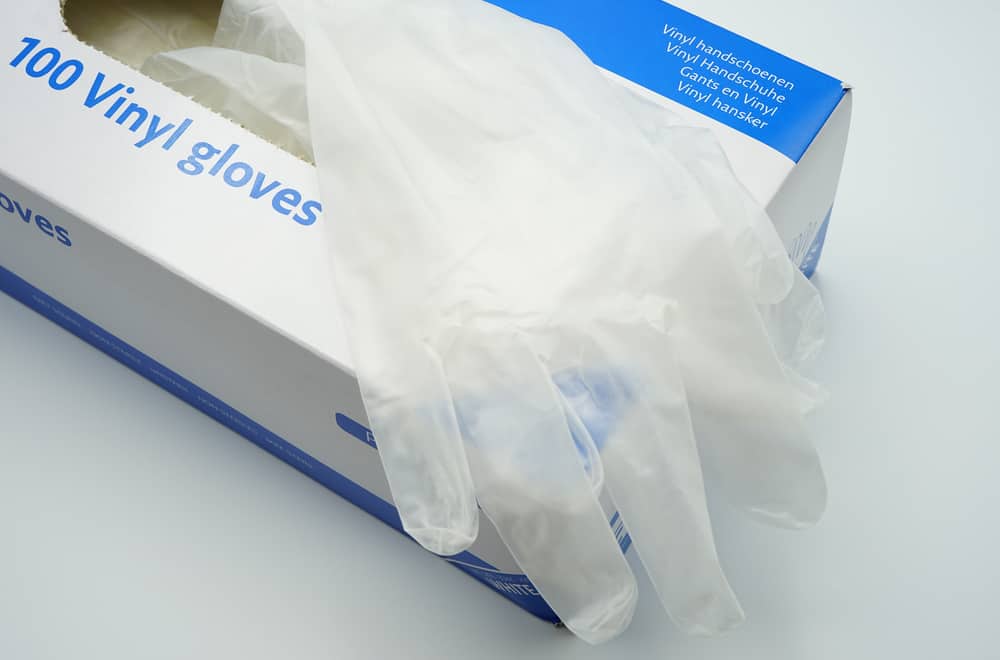Disposable gloves are necessary for healthcare facilities, but many people also use them while working in the kitchen. They are a base of hygiene and care in hospitals and sometimes the only protective barrier against harmful microorganisms.
You can choose between several models made of different materials, including three of the most convenient and common ones. However, it is unclear which option, nitrile vs. latex vs. vinyl gloves, is the best. Choosing the wrong type means spending money in vain and increasing the risk of infection. Let’s choose a good one!
Table of Contents
Nitrile Gloves
Nitrile gloves are a new synthetic rubber co-polymer that offers extra protection against petroleum-based chemicals, motor oils, epoxies, and lubricants. They are an excellent alternative for people suffering from latex allergies. Unfortunately, this artificial material has a low level of touch sensitivity.
Pros
- These sensitive medical-grade gloves provide excellent protection against bacteria and viruses and are the product of choice in contact with high-risk infectious materials
- Nitrile is a durable, flexible, and hypoallergenic material resistant to petroleum-based products, fat, oils, and chemicals
- Lightweight, easy-to-use, and breathable nitrile gloves are available in powder-free and powdered options
- You can find these gloves in a few colors, including a black variation with low sweat technology
Cons
- They are biodegradable within a century, but scientists still work on this problem
- Nitrile gloves are not too flexible, can break when overstretched, and provide a low level of touch sensitivity
- Some nitrile gloves are not food-grade
- They are expensive
Latex Gloves
Latex gloves appeared in 1894 when William Stewart Halsted decided to find a way to protect his staff working in the Johns Hopkins Hospital from chemicals. They are still the most popular choice in the healthcare industry, but you should be careful when using them if you suffer from an allergy.
Pros
- These lightweight gloves are durable, strongly sensitive, comfortable, and flexible
- This thick eco-friendly option made of natural rubber is biodegradable and with good dexterity properties
- Latex is highly resistant to toxins and water and moderately to chemicals
- These gloves will protect your hands against bleach and household detergents
- Medical latex gloves can protect you against bloodborne pathogens
- These gloves are a cost-effective option for professionals
Cons
- Latex gloves are typically protective for a limited period
- About 30% of latex glove types are permeable to bacteria and viruses
- It is a potent allergen, making it hazardous for 1 to 6% of Americans suffering from a latex allergy
- Its resistance to chemicals is pretty low
- It is almost impossible to detect signs of tears or punctures on this material once they occur
Vinyl Gloves
Disposable vinyl gloves are a petroleum-based synthetic polymer, making them a convenient and inexpensive option. Besides several advantages, the impossibility of degradability and recycling is a severe problem with this material in the modern world.
Pros
- Vinyl gloves come in four sizes and are a practical alternative for people suffering from latex allergy
- They provide decent protection in a low-risk environment and for short-term tasks
- Anti-static vinyl is flexible, readily available, and easy to use, thanks to the light powdered layer inside
- This material is resistant to household detergents, fat, vegetable oils, water, gasoline, brake fluid, bleach, and sulfuric acid
- These gloves are the most inexpensive of the three
Cons
- Vinyl gloves are susceptible to punctures and offer limited biomedical and chemical protection
- It is moderately durable and flexible, plus fat degrades it
- Its protective barrier decreases after stretching
- Powdered gloves’ prolonged use may cause skin irritation
- Vinyl is an eco-unfriendly and non-biodegradable material
Nitrile vs. Latex vs. Vinyl Gloves
All three disposable glove types, including nitrile, latex, and vinyl gloves, are considered medical-grade, but their quality and purpose differ. The crucial question is whether you need sensitive or durable gloves.
High-quality nitrile gloves are expensive but are an ultimate option for jobs that require microbial and chemical resistance. On the other hand, you can use cheap vinyl gloves for low-risk tasks and those made of latex when the user is not allergic to this material.
Nitrile vs. latex vs. vinyl gloves |
|||
| Features | Nitrile gloves | Latex gloves | Vinyl gloves |
| Flexibility | Moderate | Yes | Moderate |
| Sensitivity | Low level of touch sensitivity | Yes | Yes |
| Comfortability | Very good | Very good | Poor |
| Tensile strength | Very good | Very good | Poor |
| Waterproof | Yes | Yes | Yes |
| Biodegradable | Yes, within 100 years | Yes | Not |
| Microbial resistant | Yes | 30% are permeable to pathogens | Not |
| Chemical resistant | Resistant to biohazards, solvents, and acids | Minimal | Not |
| Toxin-protective | Yes | Yes | Not |
| Tear-resistant | Very good | Very good | Poor |
| Puncture-resistant | Very good | Moderate | |
| Latex-free | Yes | Not | Yes |
| Allergen | Not | Yes | Not |
| Allergy-protective | Yes | Not | Not |
| Safe for medical application | Yes | Yes, for people without latex allergy | Not |
| Safe for food manipulating | Yes | Yes | Yes |
| Applicability in industry | High | Moderate | Poor |
| Dishwashing | Yes | Yes | Yes |
| Eco-friendly | Yes | Yes | Not |
| Price | Most expensive | Mid-price range | Inexpensive |
| Cost efficiency | High | Moderate | Yes, for low-risk tasks |
Purpose
Nitrile gloves
Nitrile gloves are a gold standard because the material they are made of is not an allergen, and you can use them without risk of skin irritation or anaphylaxis.
Since most models are biodegradable, you can throw them away without worrying about the environment. Since they passed FDA-approved strength test, they are recommended for workers in:
- Health care
- Doctors surgeries
- Care homes
- Veterinary clinics
- Dental clinics
- Beauty salons
- Tattoo and piercing shops
- Warehouses and garages
- Waste management facilities
- Manufacturing facilities
They comfortably fit hands, making them an excellent option for:
- Laboratory work
- Food preparation
- Cleaning and sanitation
- Chemical handling
- Many general industrial tasks, particularly those that require lifting, twisting, and gripping
- Working in the automotive and janitorial industry
Since most modern models come with touch sensitivity, you can use them for an extended period and when performing high-precision tasks.
Latex gloves
Latex gloves are comfortable and durable, but this material comes with a high risk of an allergic reaction. You can use them in numerous situations when you and those who come in contact with you while wearing these gloves are not allergic.
Thanks to their sensitivity and strength, they are gloves of choice for:
- Doctors surgeries
- Operation room
- Health care
- Care homes
- Spas
- Chemical labs, due to the low chemical transmission level
- Veterinary clinics
- Dental clinics
- Beauty saloons
- Food preparation
- Cleaning purpose
- The automotive and janitorial industry
These disposable gloves are highly protective against potentially harmful chemicals and can successfully keep you safe against cross-contamination.
Vinyl gloves
Vinyl gloves fit loosely, so you shouldn’t use them when providing bathing, toilet assistance, or changing diapers. They are a cheap but excellent option for short-term use as well as low-risk infection and non-hazardous tasks, like:
- Low-risk health care applications
- Preparing non-fatty meals and serving food to prevent bacteria from transferring to food
- Light cleaning and painting without using harmful and corrosive chemicals
- Repetitive manufacturing tasks like hairdressing when short-term skin protection from chemicals is crucial
- Beauty industry
- The automotive and janitorial industry
- Jobs that require manipulating with wires and cords
Price
The glove price significantly varies depending on the used material, the manufacturer who produces them, and the brand. Typically, prices in the current market are:
- Nitrile gloves are the most expensive and cost $110 to $235 per box of 1,000
- You can find latex gloves for $115 per box of 1,000
- Those made of vinyl are the cheapest, and you need to set aside only $44 per package of 1,000
However, the price is not a crucial feature to consider. You should primarily think about gloves’ purpose because each model has unique characteristics.
For instance, nitrile gloves are pricey, but you need them when looking for long-lasting protection from microorganisms, toxins, and harmful chemicals.
On the other hand, you can spend far less by purchasing vinyl gloves for jobs that don’t require contact with microbiological material, toxins, corrosive agents, and chemicals.
Additional Considerations
According to HSE, high-quality protective disposable gloves for professionals who use them daily, particularly surgeons, doctors, and laboratory technicians, should fulfill four conditions. They need to be:
- Appropriate for the risk and the working conditions
- Preventive or to keep the possible risk under control
- Suitable for the users’ health state and ergonomic requirements
- Comfortable and perfectly fit users’ hands
Be aware that nitrile and latex gloves are similar, but you can’t use those made of latex when there is even the slightest risk of allergy.
According to the Asthma and Allergy Foundation of America, 1% to 6% of Americans suffer from a latex allergy. That number includes 8% to 17% of healthcare workers. However, these gloves are almost perfect in cases where the possibility of allergies is excluded. They are also an excellent choice for makeup artists, thanks to this material’s added sensitivity.
Nitrile gloves are recommended despite their higher price. Most people using protective disposable gloves in everyday work prefer those made of this material since it is more skin-friendly than any other option.
Summary
You can find a few glove types on the market. The best material options nowadays are safe and durable nitrile, sensitive and eco-friendly latex, and flexible and inexpensive vinyl. The choice will depend on the gloves’ purpose, the characteristics you look for, and a possible latex allergy.




